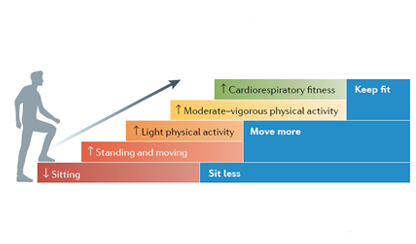 A review led by researchers from the Baker Heart and Diabetes Institute explains new ways GPs, cardiologists and other health practitioners could encourage their patients to sit less and move more to reduce their risk of cardiovascular disease.
A review led by researchers from the Baker Heart and Diabetes Institute explains new ways GPs, cardiologists and other health practitioners could encourage their patients to sit less and move more to reduce their risk of cardiovascular disease.
Such advice could be particularly beneficial for patients with multiple chronic health conditions such as arthritis and angina.
The review, published today in Nature Reviews Cardiology, suggests sitting less and moving more may be a more relevant and achievable approach than more conventional ways of specifying exercise goals and could deliver significant cardiovascular health benefits.
Titled 'Sit less and move more for cardiovascular health: emerging insights and opportunities', the comprehensive review provides a perspective that is complementary to the well-understood detrimental impacts of physical inactivity.
Head of Physical Activity Research and lead author, Professor David Dunstan says there is potential for broad cardiovascular health benefits through an integrated approach that involves 'sitting less and moving more'.
He says sitting occupies a majority of adults' daily waking hours and has become even more pervasive as a result of the COVID-19 pandemic. But he says sitting less and interrupting prolonged periods of sitting may be a good starting point for many inactive people.
Technological advances and the rise in measurable devices are now delivering new insights into how long people sit for, and Professor Dunstan says the results are cause for concern. In the past, population-based studies using self-reported measures suggested adults typically sat for 5 to 8 hours a day. However, he says device-based estimates from population-based studies of large groups show that the average sitting time is more in the range of 7.7 to 11.5 hours a day.
Professor Dunstan and his colleagues have spent several decades studying sedentary behaviour and physical activity. He says multiple studies, including those conducted at the Baker Institute, have shown that total sedentary time and longer average bouts of time spent sitting impact cardiovascular and diabetes risk. He says studies also show sedentary time impacts vascular function, blood pressure, blood glucose, blood flow to the brain, inflammation, and can even blunt the cardio-protective benefits of exercise.
He says this highlights a fundamental principle that high levels of sitting displace total physical activity time, negating the cardiovascular benefits of skeletal muscle activity. Importantly, it appears that very high levels of daily physical activity (60–75 mins/day) are required to make up for large amounts of time spent sitting.
Professor Dunstan says 30 scientific trials have tested interventions to reduce and break up the long periods of time that many adults spend sitting. The most successful interventions have been those that have include some form of environmental change, such as the introduction of sit-stand workstations which reduced sedentary behaviour by an average of 40 minutes per day.
So with so much research undertaken and more to be done, just what is the current advice?
"Sit less and move more," says Professor Dunstan. "This may be easier and more effective for people to integrate into their day than making the big transition from being inactive to undertaking a regular exercise program. This can then help them transition to more physical activity in future.".






